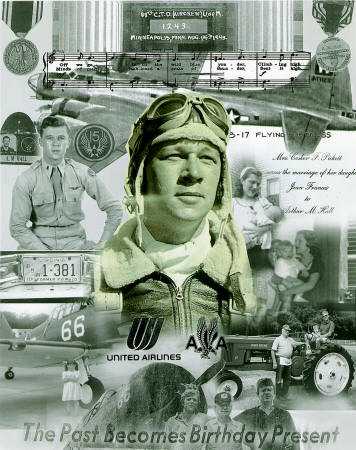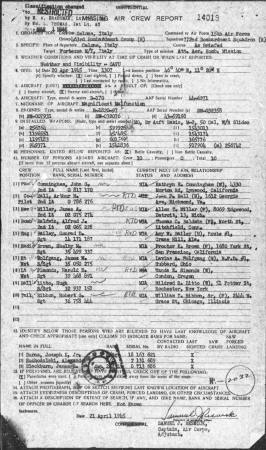Magnificent Malfunction
APRIL 20, 1945 OPERATIONS
The Strategic Air Force dispatched a total of 1332 aircraft, including 251 B-17, 532 B-24, 218 P-38 and 260 P-51 from the Fifteenth Air Force and 71 Liberators from 205 Group RAF.
In an effort to retard supply or withdrawal of enemy forces in Italy, heavy bombers attacked rail targets in the Brenner transportation system and road bridges ahead of the Eight Army.
Dive bombers attacked Innsbruck, Rosenheim and Rattenburg.
Escort and recon missions were also flown.
Night bombers attacked roads and supply dumps in advance of the Eight Army.
Two (2) enemy aircraft were encountered.
Losses amounted to eight (8) heavy bombers.
BRENNER TRANSPORTATION SYSTEM:
251 B-17, 249 B-24 with escort of 36 P-38 and 116 P-51 were dispatched from 5th, 47 and 304th Bomber Wings and from 305th and 306th Fighter Wings to attack the following rail transportation targets:
1) CAMPODAZZO RR/BR
2) PONTE GARDENA RR/BR
3) MAIRHOF RR VIADUCT
4) VIPITENO M/Y
5) FORTEZZA M/Y
6) AVISIO RR VIADUCT
7) CAMPO DI TRENS RR VIADUCT
8) BRENNERM/Y
9) INNSBRUCK MAIN M/Y
10) TARGETS OF PPORTUNITY
THE BOMBING OF FORTEZZA MARSHALLING YARDS:
71 B-17 dropped 200.75 tons of 500lb RDX bombs (803 bombs ) and 300000 leaflets between 11:49 / 12:42 hours from 25000/27000 feet.
Aircraft of the 97th and 463rd BG s attacked visually; the 483rd BG by both visual and offset methods.
Results:
Bomb strikes photos show bombs carried across North and South choke points severing the entrance tracks.
Scattered damage was also observed to siding tracks at the North and South ends of the yards.
Opposition:
Intense, accurate, heavy Flak at Fortezza.
Source:
AFHRA reel A-6117.
THE LAST FLIGHT OF “MAGNIFICENT MALFUNCTION”
Among the eight heavy bombers lost on April 20, 1945, there was the B-17G s/n 44-6271 nickname ”Magnificent Malfunction” belonging to the 772nd BS/ 463rd BG.
Aboard the aircraft were the following airmen:
Pilot: 2nd Lt. John J. Canningham from Lynwood, California
Co-pilot: 2nd Lt. Arthur M. Hall from Richmond, Virginia
Bombardier: 2nd Lt. Alfred J. Baldwin from from Litchfield, Connecticut
Navigator: 2nd Lt. James A. Miller from Detroit, Michigan
Radio Operator: Sgt. Shelby M. Brown from San Francisco, California
Engeneer: Sgt. Conrad B. Bailey from Crane Hill, Alabama
Ball Gunner: Sgt.Hugh Litto from Rochester, New York
R.Waist Gunner: Sgt. James W. Wolfgang from Hubbard, Ohio
L.Waist Gunner: Sgt. Harold E. Simonds from Condon, Oregon
Tail Gunner: Sgt. Robert G. Ribbon from Chicago, Illinois
The Fortress was hit by heavy a/a fire shortly after the bombs were dropped, over the target area, started losing speed and altitude but the Pilot, 2nd Lt. Cunningham, elected to try to reach Allied held territory (at that stage of the war, the advancing Allied troops had just broken the Gothic Line and were driving to the Po river) as the Navigator, 2nd Lt. James A. Miller, was wounded and not able to bail out.
“Magnificent Malfunction” left formation over Bolzano and slowly made its way South until, a few minutes after passing Verona, the Pilot was forced to order the rest of the the crew to bail out.
Eight airmen jumped from the stricken Fortress while 2nd Lt. Cunningham attempted to crash-land the aircraft.
He brought the plane down near Casalmaggiore, near Cremona, where the B-17 crashed in flames on the North bank of the Po river.
The Navigator, 2nd Lt. James A. Miller, was miraculously extracted from the wrecked plane by a local civilian and survived the experience while 2nd Lt. Cunnigham lost his life.
Sadly, several fascist soldiers opened fire with rifles and machine guns on the descending parachutes and airmen; Sgt. Brown was killed while Sgt. Litto was wounded and later murdered .
The other airmen were taken prisoners by German soldiers.
A “CALL” FROM THE USA:
The following is the background story of how Arthur M. Hall, Jr. (son of Arthur M. Hall), co-pilot of the Magnificent Malfunction; Skyler Bailey, grandson of Alfred Baldwin, Bombardier; and Ago, Luca and Stefano (Italians archaeologists) got together.
On April 20, 2015, Arthur M. Hall, Jr. (Mac) held a luncheon for his father, Arthur M. Hall in recognition of the 70th anniversary of the Magnificent Malfunction being shot down. The local news paper was there and printed the story mentioning the name of the aircraft M/M.
Ago and his group discovered the crash site of the Magnificent Malfunction, and collected some of the Italians' recollection of the crash. They also went over the area with metal detectors and unearthed a few fragments of the plane. Ago, saw the story of the luncheon for Arthur M. Hall on the internet and contacted Skyler Bailey to see if he could get in touch with Mac.
Mac, Skyler, and Ago have been sharing information on the M/M for the past two months. Ago, Stefano and Luca have sent Mac and Skyler pieces of the B-17 G s/n 44-6271 “ Magnificent Malfunction."
Most of the photos below are thumbnails.
Please click on a photo to enlarge it.
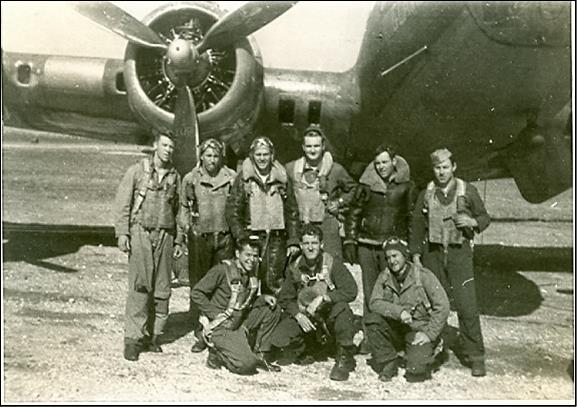
All but two of the crew of the "Magnificent Malfunction."
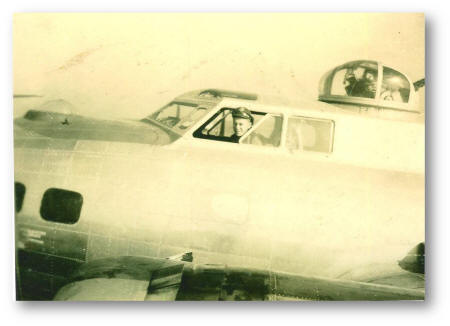
2nd Lt. Hall aboard "Magnificent Malfunction."

"Casualty questionnaires received from the members of Lt. Cunningham's crew
who have returned to duty indicate that he elected to remain in his plane
and take a crash landing in order to save a wounded man aboard the ship.
The wounded man survived the crash; however, Lieutenant Cunningham died due
to a broken back, sustained when the plane crashed. It is requested
that he be considered for an appropriate award for the heroism he displayed.
Copies of casualty questionnaires forwared for whatever action you deem
necessary. No other action has been taken by this headquarters."
Researching around the crash-point.
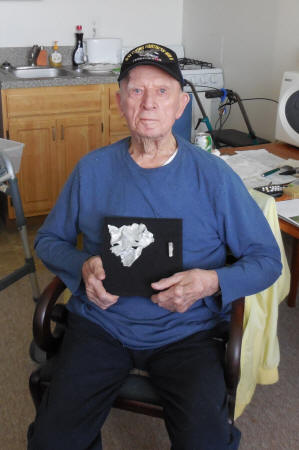
Lt. Hall holding the part of the plane that Air Crash Po sent to him.
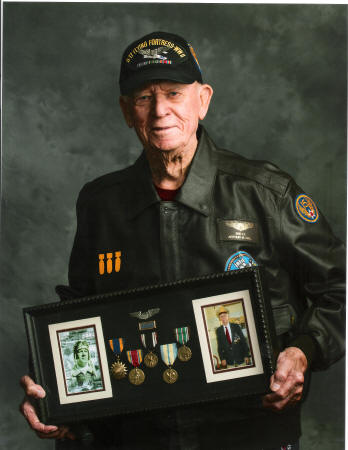
Lt. Hall displaying his medals.
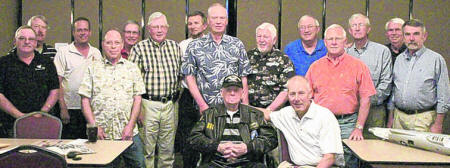
2nd Lt. Arthur M. Hall (center).
YouTube Video
This is a 3-minute video showing the Air Crash Po Team using metal detectors, searching for the remains of the Magnificent Malfunction.
https://www.youtube.com/watch?v=Vzt9JqX-4eQ
Newspaper Article
This article is from the Richmond Times-Dispatch in Richmond, Virginia, USA. The article is dated 28 April, 2015. The article is titled: "70 years later: local man recalls bailing from B-17." Mechanicsville, Virginia, is a suburb or Richmond.
We are reproducing the text of the newspaper article below in case the article is ever deleted from the newspaper's archive:
|
Posted: Tuesday, April 28, 2015 11:05 pm By Meredith Rigsby MECHANICSVILLE — Donning a leather jacket with three yellow bombs painted on the right breast, Arthur M. “Mac” Hall Sr. watches as men gather in the back room of Anna’s Italian Restaurant and Pizzeria to celebrate the 92-year-old’s service and survival during World War II. A pilot in the Air Army Forces, Hall’s Boeing B-17 Flying Fortress was struck down in Italy by German forces. The three yellow bombs on his jacket represent the three bombing missions that Hall flew during the war. The year was 1942 and Hall had decided he wanted to become an aviator in the Air Army Forces, the predecessor to the U.S. Air Force. “He ended up at the University of Minnesota, went through flight school in Arizona, next thing you know he’s in Nellis Air Force Base in Nevada,” said Arthur M. “Mac” Hall Jr. “Picked up a B-17, flew it across country, left from Florida, flew all the way up the East Coast around through Newfoundland and in through west Africa on into Italy.” During his third mission, co-pilot Hall Sr. and the 463rd Bombardment Group took off on April 20, 1945, to target railroad marshalling yards in northern Italy. After deploying bombs in the area, Hall Sr. and his crew of eight turned the plane around and were headed back to base when they were struck. The four-engine B-17 bomber, named the “Magnificent Malfunction No. 2,” was hit at 25,600 feet, knocking one engine out and catching another on fire. As the plane was descending, the aircraft’s commander, Lt. John Cunningham, attempted to turn the plane on its side to get an apprehensive crew member to jump out. This decision would take his life. “They let us have it, you might say, right at the time they closed the bomb bay doors on our airplane, they let us have it,” said Hall Sr. “We had to take over, we lost two engines. The other two were still flying. We flew a half hour to 45 minutes and that’s when I bailed out. It didn’t take too long for them to pick me up and take my chute, my gun and everything.” Hall Sr. jumped out of the aircraft at about 1,600 feet. “That saved my life,” he said. “I was one of the last ones to bail out of there.” There were 42 planes involved in two raids that same day. Twenty-one planes were damaged by flak and two went down, the Mary Lou and the Magnificent Malfunction. After parachuting to the ground and landing in a peach orchard, it wasn’t much time until Hall Sr. was captured and taken as a prisoner of war. He was interrogated by a German chief investigator and then taken to a German prison camp. Three weeks later, on May 8, 1945, Germany surrendered and Hall Sr. and his fellow prisoners of war (POWs) awoke to a deserted prison camp. Hall Sr. and other U.S. troops made their way to a troop ship and by May 11 were on their way home. “I’m 70 years away from the last day that I flew the last one of these airplanes, if you can picture that,” Hall Sr. said. “That’s a big deal for me.” |

